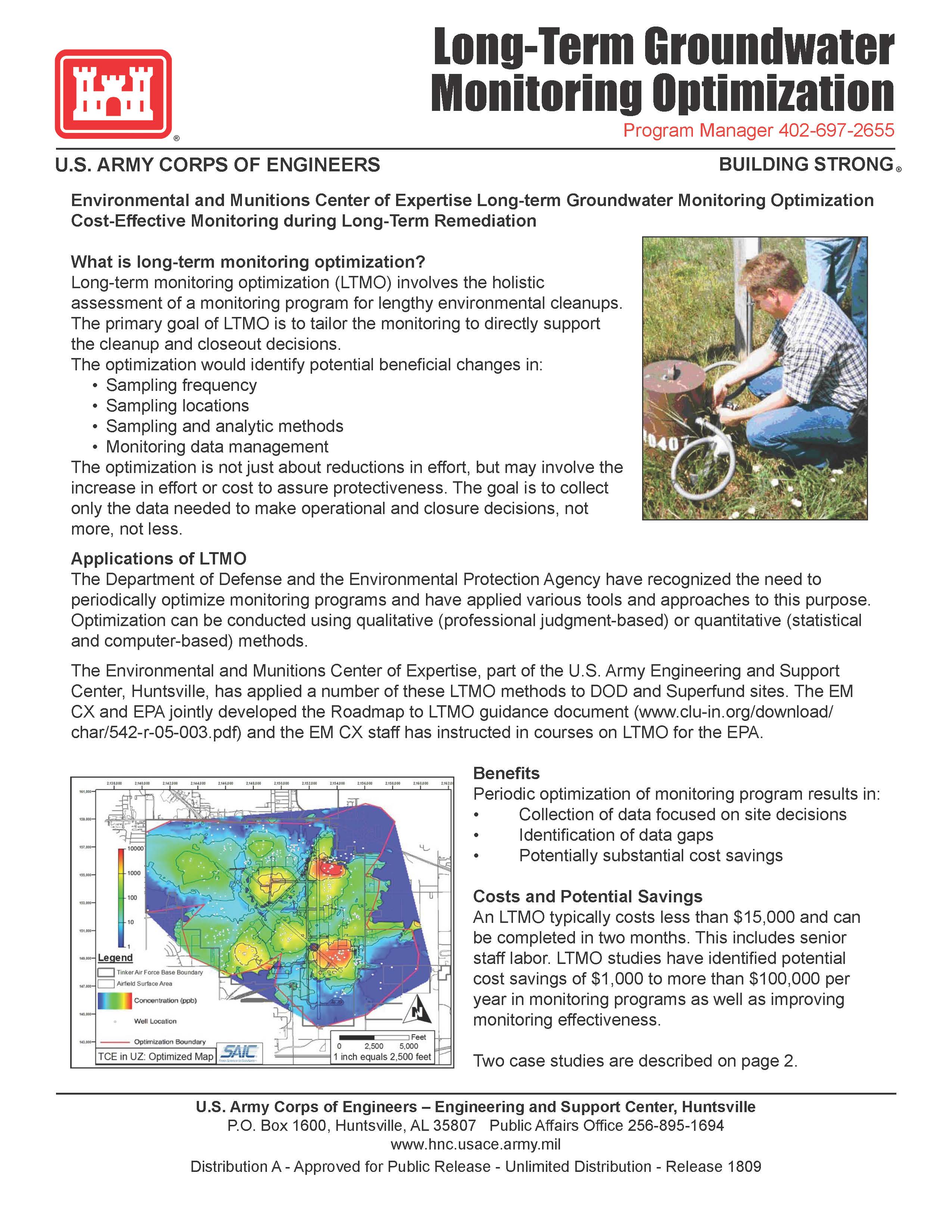Long-Term Monitoring Optimization involves the holistic assessment of a monitoring program for lengthy environmental cleanups. The primary goal of LTMO is to tailor the monitoring to directly support the cleanup and closeout decisions. The optimization would identify potential beneficial changes in:
- Sampling and analytic methods
- Monitoring data management
The optimization is not just about reductions in effort, but may involve the increase in effort or cost to assure protectiveness. The goal is to collect only the data needed to make operational and closure decisions, not more, not less.
Applications of LTMO
The Department of Defense and the Environmental Protection Agency have recognized the need to periodically optimize monitoring programs and have applied various tools and approaches to this purpose. Optimization can be conducted using qualitative (professional judgment-based) or quantitative (statistical and computer-based) methods.
The Environmental and Munitions Center of Expertise, part of the U.S. Army Engineering and Support Center, Huntsville, has applied a number of these LTMO methods to DOD and Superfund sites. The EM CX and EPA jointly developed the Roadmap to LTMO guidance document (available here) and the EM CX staff has instructed in courses on LTMO for the EPA.
Benefits
Periodic optimization of monitoring program results in:
- Collection of data focused on site decisions
- Identification of data gaps
- Potentially substantial cost savings
Costs and Potential Savings
An LTMO typically costs less than $15,000 and can be completed in two months. This includes senior staff labor. LTMO studies have identified potential cost savings of several thousand dollars to over $100,000 per year in monitoring programs as well as improving monitoring effectiveness.
Case Study Number 1
Background
The monitoring program at a site on a former Air Force base was optimized. The former waste storage site has been redeveloped and portions of the monitoring network had been lost during construction at the site. The remaining network was limited in extent but sampled semi-annually for volatile organics (VOCs) and metals. There is no active remedy, but evidence of reductive dechlorination of the VOCs.
Findings
A qualitative (professional judgment-based) and quantitative (using the free MAROS LTMO software available here) was conducted. Findings included:
- Ground water flow directions had changed in the past five years.
- The monitoring network was inadequate to assess plume migration. Additional wells were recommended.
- One contaminant was migrating onto the site from a previously unidentified upgradient source.
- Semi-annual sampling was unnecessary and redundant wells existed in parts of the site.
- Annual sampling was appropriate for most wells. Several wells were recommended for removal from the monitoring program. The number of samples per year could be reduced from about 38 to 19.
Benefits and Costs
The resulting monitoring program would better evaluate the adequacy of natural attenuation. The reduced monitoring effort resulted in a projected annual savings of $12,000. The LTMO at this site cost approximately $5,000.
Case Study Number 2
Background
The monitoring program at a Superfund site in Texas was evaluated using the MAROS LTMO software and professional judgment. The site consists of multiple disposal locations for oil and petrochemical waste. Site materials included silts and clays over silty sands. A deeper sand aquifer exists beneath an underlying clay layer. Contaminants included benzene, vinyl chloride, 1,2-DCA and naphthalene. Monitored natural attenuation was being considered as the site remedy. Sampling had been conducted quarterly in 170 wells.
Findings
The optimization included assessment of recent concentration trends and contaminant distribution at five sub-sites. Conclusions included:
- Plumes at four of the five sites required additional wells to define the plumes, some of which had evidence for recent expansion.
- Concentrations appeared to be increasing in the deep sand and the deep monitoring network was not adequate.
- Annual sampling would be adequate for most monitoring points.
- Most sites had redundant wells in the interior of the plumes.
- Sampling efforts could be reduced from 680 samples per year to about 180.
Benefits and Costs
The recommended program would be better able to assess plume stability for MNA. The LTMO cost was $12,000, but had projected annual savings of more than $175,000 not including the costs for new monitoring points.
 Download the Long-term Ground Water Monitoring Optimization Fact Sheet (PDF)
Download the Long-term Ground Water Monitoring Optimization Fact Sheet (PDF)
Long-term Ground Water Monitoring Optimization fact sheet
(as of September 2022)